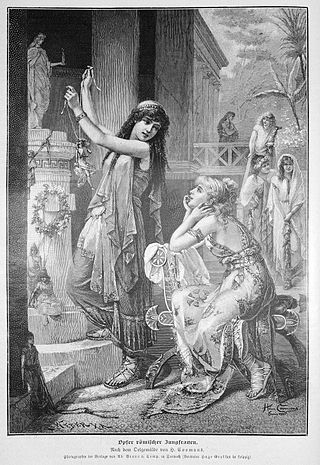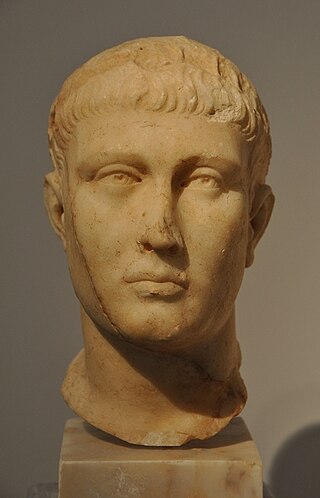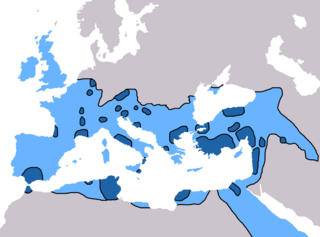Related Research Articles

Julian was the Caesar of the West from 355 to 360 and Roman emperor from 361 to 363, as well as a notable philosopher and author in Greek. His rejection of Christianity, and his promotion of Neoplatonic Hellenism in its place, caused him to be remembered as Julian the Apostate in Christian tradition. He is sometimes referred to as Julian the Philosopher.

Paganism is a term first used in the fourth century by early Christians for people in the Roman Empire who practiced polytheism, or ethnic religions other than Judaism. In the time of the Roman Empire, individuals fell into the pagan class either because they were increasingly rural and provincial relative to the Christian population, or because they were not milites Christi. Alternative terms used in Christian texts were hellene, gentile, and heathen. Ritual sacrifice was an integral part of ancient Graeco-Roman religion and was regarded as an indication of whether a person was pagan or Christian. Paganism has broadly connoted the "religion of the peasantry".

Theodosius I, was Roman emperor from 379 to 395. During his reign, he succeeded in a crucial war against the Goths, as well as in two civil wars, and was instrumental in establishing the creed of Nicaea as the orthodox doctrine for Christianity. Theodosius was the last emperor to rule the entire Roman Empire before its administration was permanently split between the West and East.
Rutilius Claudius Namatianus was a Roman Imperial poet, best known for his Latin poem, De reditu suo, in elegiac metre, describing a coastal voyage from Rome to Gaul in 417. The poem was in two books; the exordium of the first and the greater part of the second have been lost. What remains consists of about seven hundred lines.

Konstantinos Petrou Kavafis, known, especially in English, as Constantine P. Cavafy and often published as C. P. Cavafy, was a Greek poet, journalist, and civil servant from Alexandria. His work, as one translator put it, "holds the historical and the erotic in a single embrace."

Daniel Adam Mendelsohn is an American author, essayist, critic, columnist, and translator. Best known for his internationally best-selling and award-winning Holocaust family memoir The Lost: A Search for Six of Six Million, he is currently the Charles Ranlett Flint Professor of Humanities at Bard College, the Editor at Large of the New York Review of Books, and the Director of the Robert B. Silvers Foundation, a charitable organization dedicated to supporting writers of nonfiction.
"The God Abandons Antony" can also be translated as "The God Forsakes Antony" is a poem by Constantine P. Cavafy, published in 1911.

The "Coptic period" is an informal designation for Late Roman Egypt and Byzantine Egypt. This era was defined by the religious shifts in Egyptian culture to Coptic Christianity from ancient Egyptian religion, until the Muslim conquest of Egypt in the 7th century.

Paganism is commonly used to refer to various religions that existed during Antiquity and the Middle Ages, such as the Greco-Roman religions of the Roman Empire, including the Roman imperial cult, the various mystery religions, religions such as Neoplatonism and Gnosticism, and more localized ethnic religions practiced both inside and outside the empire. During the Middle Ages, the term was also adapted to refer to religions practiced outside the former Roman Empire, such as Germanic paganism, Egyptian paganism and Baltic paganism.
The City is a famous Greek philosophical poem by Constantine Cavafy. It was written in August 1894, originally entitled “Once More in the Same City.” It was then published in April 1910.

Christianity in the 4th century was dominated in its early stage by Constantine the Great and the First Council of Nicaea of 325, which was the beginning of the period of the First seven Ecumenical Councils (325–787), and in its late stage by the Edict of Thessalonica of 380, which made Nicene Christianity the state church of the Roman Empire.

The Religious policies of Constantine the Great have been called "ambiguous and elusive." Born in 273 during the Crisis of the Third Century, Constantine the Great was thirty at the time of the Great Persecution. He saw his father become Augustus of the West and then shortly die. Constantine spent his life in the military warring with much of his extended family, and converted to Christianity sometime around 40 years of age. His religious policies, formed from these experiences, comprised increasing toleration of Christianity, limited regulations against Roman polytheism with toleration, participation in resolving religious disputes such as schism with the Donatists, and the calling of councils including the Council of Nicaea concerning Arianism. John Kaye characterizes the conversion of Constantine, and the Council of Nicea that Constantine called, as two of the most important things to ever happen to the Christian church.
Secular paganism, naturalistic paganism, or humanistic paganism is an outlook which upholds virtues and principles associated with paganism while maintaining a secular worldview. Approaches to secular paganism vary, but can include the respect for living creatures and the Earth itself, while rejecting belief in deities. Secular pagans may recognize goddesses/gods as useful metaphors for different cycles of life, or reframe magic as a purely psychological practice.
"Ithaca" is a 1911 poem by Constantine P. Cavafy that is generally considered his best-known work. Based on the homeward journey of Odysseus in Homer's Odyssey, the poem gained a global audience upon its 1994 reading at the funeral of Jacqueline Kennedy Onassis.
"Waiting for the Barbarians" is a Greek poem by Constantine P. Cavafy. It was written in November 1898 and printed around December 1904, as a private pamphlet. This poem falls under the umbrella of historical poems Cavafy created in his anthology.
Polymnia Athanassiadi is a historian specialising in the religious and cultural history of Late Antiquity, in particular the transition from Neoplatonic to Islamic theology. Athanassiadi was a Professor of Ancient History at the University of Athens.

Konstantinos Dimitriadis, better known by his pen name Dinos Christianopoulos, was a Greek contemporary and post-war poet, novelist, folklorist, and scholar. He was also a music scholar who wrote about rebetiko.
Alexandrian Kings is a 1912 Greek poem by Constantine P. Cavafy which can be generally seen as a lesser-known poem from his anthology. He wrote this poem in the Spring of 1912 and was published soon after, in July 1912. This work is based on Cavafy's appreciation for Ancient history, specifically that of Ancient Greece and Ancient Egypt. The poem is set during Cleopatra’s reign in Alexandria, as the name suggests.
In Sparta is a Greek poem by Constantine P. Cavafy. It was published on 17 April 1928. This both can be recognised as both a historical and political poem in Cavafy’s anthology.
References
- 1 2 Cavafy, C. P. (2009). C. P. Cavafy Collected Poems - Bilingual Edition. Robert Pinsky, Philip Sherrard, Edmund Keeley, George Savidis, Project Muse, Project MUSE. Princeton. ISBN 978-0-691-14124-4. OCLC 1300428945.
{{cite book}}: CS1 maint: location missing publisher (link) - 1 2 Μάντης, Κωνσταντίνος. "Κωνσταντίνος Καβάφης: Μύρης Αλεξάνδρεια του 340 μ.Χ". latistor.blogspot.com. Retrieved 2023-03-23.
- 1 2 3 "Καβάφης: Σκέψεις πάνω σε ένα ποιήμα του [ Μύρης ]". Fanis1952's Blog (in Greek). 2010-01-03. Retrieved 2023-03-23.
- ↑ Cavafy, Constantine; Mendelsohn, Daniel. "Myres: Alexandria in 340 AD | Daniel Mendelsohn". ISSN 0028-7504 . Retrieved 2023-03-23.
- 1 2 3 "Η ποιητική της ανασκαφής και της μετάβασης". Αυγή (in Greek). 2017-04-17. Retrieved 2023-03-23.
- ↑ Auden, W. H. (1962). "The Poet & The City". The Massachusetts Review. 3 (3): 449–474. ISSN 0025-4878. JSTOR 25086852.
- ↑ Dimaras, C. Th.; Haas, Diana (1983). "Cavafy's Technique of Inspiration". Grand Street. 2 (3): 143–156. doi:10.2307/25006511. ISSN 0734-5496. JSTOR 25006511.